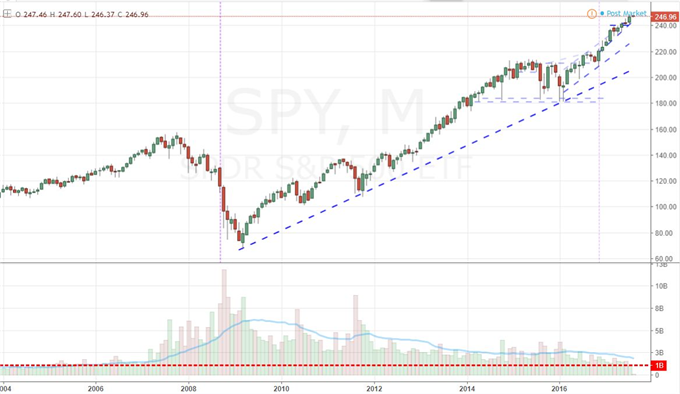Talking Points:
- Pound drops after the Bank of England lowered its growth forecast while simultaneously stating greater rate sensitivity
- While political risk circulates through the market, top billed event risk ahead is the July NFPs release
- With EUR/USD sporting the most one-sided, anti-Dollar position in 5 years; there is a skew in potential event impact
Both the EUR/USD and S&P 500 have clear significant resistance recently. What has this remarkable progress meant in terms of speculators' trading? See the IG positioning data on the DailyFX Sentiment page.
The market continues to power down with volatility flagging despite benchmarks like the S&P 500 and the Dollar standing at extreme of their respective trends - bullish and bearish respectively. Seasonal and structural restrictions remain for trading appetite leading to the SPDR S&P 500 ETF (SPY) registering its lowest month of volume in July in over 15 years while the VIX volatility index meanders near 10 and FX markets pay less and less head to the weather patterns in monetary policy. This contrast between market pricing and activity level has led to considerable debate over how to trade. Should we look for measured moves that account for restrained progress or commit to ride out persistent but slow trends? I prefer the former, but conditions and trading commentary suggest there is plenty of interest behind both approaches.
To help charge volatility for discrete trade opportunity this past session, the Bank of England rate decision spurred a meaningful correction on the currency over a number of its crosses. GBP/USD eased back its advance attempting to further recover ground lost during the Brexit fallout. While putting in for the biggest drop in a month, the Cable finds itself facing significant support in the form of a confluence of a 38.2% Fibonacci retracement of the post-Brexit range and support in a rising wedge. The next move from here would arguably be the more meaningful development, but it would make sense that such a move would take greater conviction. In the BoE rate decision, the downgrade in growth forecasts throttles rate forecasts that had recently swelled, but a reported policy sensitivity to positive economic surprises kept the option open for hikes. That lack of clarity for fundamentally-driven trade potential was clearly registered. Among the other Sterling crosses that present perhaps better technicals and fewer fundamental crosswinds; I am watching GBP/JPY, GBP/CHF and GBP/NZD closely for different configurations.
Ahead, the top billed event risk will be the US employment report. NFPs updates are frequent market movers, but they are certainly not guaranteed. There are a few necessary preconditions that need to be met before the event can leverage a strong market reaction. The degree of surprise is one aspect but the ability to tap a deeper fundamental current is arguably the most crucial element. US employment data has not lately driven a meaningful shift in growth forecasts to substantial market response. Through the more trafficked monetary policy outlet, the markets have proven very reticent to alter their expectations on the Fed's policy bearings - currently set to afford a less than 50 percent chance of another hike by the end of the year. That said, the Dollar's heavy battering the past months puts it in a better position to response to a positive surprise. A less covered event risk, but one that has proven capable of generating greater volatility is the Canadian jobs report. There are a range of pairs like CAD/JPY to CAD/CHF that are technically and fundamentally interesting, but the USD/CAD could represent the most at-risk for volatility. We discuss both trading conditions and opportunities ahead in today's Trading Video.
To receive John’s analysis directly via email, please SIGN UP HERE.







